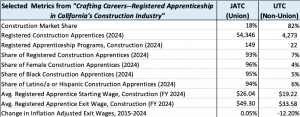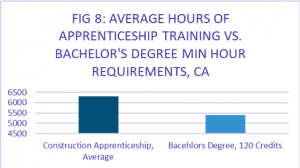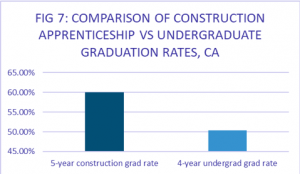New Report: Union Apprenticeships Powering Workforce Growth in California Construction Industry
SACRAMENTO, CA, UNITED STATES, October 22, 2025 /EINPresswire.com/ -- The annual number of California workers graduating registered apprenticeship programs in the construction trades has surged nearly 62% over the last decade, according to a new study released by industry watchdog NorCal Construction Industry Compliance (NCIC). In particular, the report details how union-affiliated apprenticeship programs have led the industry’s efforts to expand and diversify its labor force--finding that these programs train nine out of every ten registered construction apprentices in the state, including 96% of female construction apprentices, 95% of black apprentices, and 94% of Hispanic apprentices. It notes that union programs also graduate workers at a higher rate than four-year colleges, deliver average annual wages that rival workers with college degrees, and offer participants average annual wage increases that have kept pace with inflation.
Read the Report, “Crafting Careers: Registered Apprenticeship in California’s Construction Industry.”
Registered apprenticeships are a tuition-free workforce development system, where programs must meet nationally recognized standards established by the US Department of Labor to provide participants with portable, industry-recognized credentials. Depending on the trade, programs can take up to five years to complete, combining a mix of classroom and on-the-job training for which participants earn a paycheck. California has the nation’s largest registered apprenticeship system, and over 63% of its apprentices are in the fast-growing construction industry, which employed 4% (nearly 700,000 workers) of all California workers and contributed $129 billion to the state’s GDP in 2024.
Within the construction industry, there are two types of programs. “JATCs” or joint programs are cooperatively administered as a partnership between construction trade unions and employers, and funded through a “cents” contribution for every hour a union-tradesperson works—an institutionalized financing mechanism negotiated during the collective bargaining process. “UTC’s” or Unilateral Training Committees are administered entirely by employers or employer trade associations and funded through voluntary contributions.
“The lack of an institutional funding mechanism like collective bargaining for UTCs may lead many firms to forego long-term workforce development investments in an effort to lower bids and win short-term work,” Petrucci noted. “This inevitably leads to less workforce training investment in the non-unionized side of the industry, where prior research has shown labor shortages to be most pervasive.”
Analyzing US Department of Labor data on nearly 60,000 registered construction apprentices across 30 trades and 171 individual programs in California, Dr. Petrucci was able to identify significant distinctions between the JATC and UTC training models.
“From enrollment and expanding workforce supply from historically under-represented demographics, to wages that attach workers to careers in the industry and keep pace with rising costs, the data is pretty clear that the unionized side of California’s construction sector is punching well above its weight,” Petrucci added. “As the industry grapples with historic demand for construction services and enough skilled workers to get the job done right, the data is pretty unambiguous about which training model is delivering the best outcomes.”
In addition to comparing outcomes between the Joint and Unilateral training models for training construction apprentices, Petrucci also compared outcomes associated with Registered Construction apprenticeships more broadly with other workforce training institutions—such as four year college degrees.
The data reveal that construction apprenticeships provide substantially more training hours for participants than California bachelors degree programs, deliver substantially higher graduation rates, and produce average exit wages on par with college graduates.
“When you consider that Registered Apprenticeships are tuition-free career training opportunities, and college degrees can carry tuition costs well into the six figures, these differences really are especially significant,” Petrucci added. “Registered apprenticeships in construction are providing viable pathways for workers seeking to access good paying careers within in-demand industries, without accumulating a mountain of debt.”
Registered Construction apprenticeships have been on a trajectory of rapid growth in California over the past ten years, with the number of skilled construction apprentice graduates increasing by 62% (from 4428 to 7272) between 2013 and 2023.
Petrucci credits a range of policy interventions for the increase, including expansion of policies such as prevailing wage and project labor agreements that boost Joint program funding and apprentice utilization on projects. She also credits the emergence of pre-apprenticeship programs—multi-week training programs funded by state grants that offer both introductory construction skills and wraparound services like child-care, transportation and career counseling to help the industry expand its access to historically under-utilized labor supply pools.
“Construction is predicted to be one of California’s fastest growing industries well into the forseeable future,” Petrucci concluded. “With the emergence of JATCs as the gold standard for delivering the sufficiently skilled workforce that the industry needs, it is clear that public policies that create more pathways into these programs are critical for meeting the long-term workforce development imperatives of employers, the safety and quality needs of projects, and the economic imperative of providing more debt-free pathways into the middle class.”
####
About the Author
Larissa Petrucci, PhD, is a policy and research analyst at NCIC specializing in labor compliance, project labor agreements, and
construction apprenticeship.
About NCIC
NorCal Construction Industry Compliance is a joint labor-management organization committed to creating a level playing field for contractors and workers by promoting equitable contracting and enforcing state and federal labor laws across California's construction industry. Learn more at https://norcalcic.org/
Read the Report, “Crafting Careers: Registered Apprenticeship in California’s Construction Industry.”
Registered apprenticeships are a tuition-free workforce development system, where programs must meet nationally recognized standards established by the US Department of Labor to provide participants with portable, industry-recognized credentials. Depending on the trade, programs can take up to five years to complete, combining a mix of classroom and on-the-job training for which participants earn a paycheck. California has the nation’s largest registered apprenticeship system, and over 63% of its apprentices are in the fast-growing construction industry, which employed 4% (nearly 700,000 workers) of all California workers and contributed $129 billion to the state’s GDP in 2024.
Within the construction industry, there are two types of programs. “JATCs” or joint programs are cooperatively administered as a partnership between construction trade unions and employers, and funded through a “cents” contribution for every hour a union-tradesperson works—an institutionalized financing mechanism negotiated during the collective bargaining process. “UTC’s” or Unilateral Training Committees are administered entirely by employers or employer trade associations and funded through voluntary contributions.
“The lack of an institutional funding mechanism like collective bargaining for UTCs may lead many firms to forego long-term workforce development investments in an effort to lower bids and win short-term work,” Petrucci noted. “This inevitably leads to less workforce training investment in the non-unionized side of the industry, where prior research has shown labor shortages to be most pervasive.”
Analyzing US Department of Labor data on nearly 60,000 registered construction apprentices across 30 trades and 171 individual programs in California, Dr. Petrucci was able to identify significant distinctions between the JATC and UTC training models.
“From enrollment and expanding workforce supply from historically under-represented demographics, to wages that attach workers to careers in the industry and keep pace with rising costs, the data is pretty clear that the unionized side of California’s construction sector is punching well above its weight,” Petrucci added. “As the industry grapples with historic demand for construction services and enough skilled workers to get the job done right, the data is pretty unambiguous about which training model is delivering the best outcomes.”
In addition to comparing outcomes between the Joint and Unilateral training models for training construction apprentices, Petrucci also compared outcomes associated with Registered Construction apprenticeships more broadly with other workforce training institutions—such as four year college degrees.
The data reveal that construction apprenticeships provide substantially more training hours for participants than California bachelors degree programs, deliver substantially higher graduation rates, and produce average exit wages on par with college graduates.
“When you consider that Registered Apprenticeships are tuition-free career training opportunities, and college degrees can carry tuition costs well into the six figures, these differences really are especially significant,” Petrucci added. “Registered apprenticeships in construction are providing viable pathways for workers seeking to access good paying careers within in-demand industries, without accumulating a mountain of debt.”
Registered Construction apprenticeships have been on a trajectory of rapid growth in California over the past ten years, with the number of skilled construction apprentice graduates increasing by 62% (from 4428 to 7272) between 2013 and 2023.
Petrucci credits a range of policy interventions for the increase, including expansion of policies such as prevailing wage and project labor agreements that boost Joint program funding and apprentice utilization on projects. She also credits the emergence of pre-apprenticeship programs—multi-week training programs funded by state grants that offer both introductory construction skills and wraparound services like child-care, transportation and career counseling to help the industry expand its access to historically under-utilized labor supply pools.
“Construction is predicted to be one of California’s fastest growing industries well into the forseeable future,” Petrucci concluded. “With the emergence of JATCs as the gold standard for delivering the sufficiently skilled workforce that the industry needs, it is clear that public policies that create more pathways into these programs are critical for meeting the long-term workforce development imperatives of employers, the safety and quality needs of projects, and the economic imperative of providing more debt-free pathways into the middle class.”
####
About the Author
Larissa Petrucci, PhD, is a policy and research analyst at NCIC specializing in labor compliance, project labor agreements, and
construction apprenticeship.
About NCIC
NorCal Construction Industry Compliance is a joint labor-management organization committed to creating a level playing field for contractors and workers by promoting equitable contracting and enforcing state and federal labor laws across California's construction industry. Learn more at https://norcalcic.org/
Todd Stenhouse
Stenhouse Strategies Inc.
toddstenhouse@gmail.com
Legal Disclaimer:
EIN Presswire provides this news content "as is" without warranty of any kind. We do not accept any responsibility or liability for the accuracy, content, images, videos, licenses, completeness, legality, or reliability of the information contained in this article. If you have any complaints or copyright issues related to this article, kindly contact the author above.




